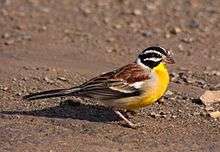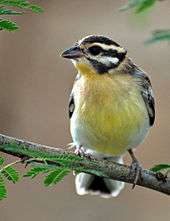Golden-breasted bunting
| Golden-breasted bunting | |
|---|---|
 | |
| In Hluhluwe-Umfolozi Game Reserve, South Africa | |
| Scientific classification | |
| Kingdom: | Animalia |
| Phylum: | Chordata |
| Class: | Aves |
| Order: | Passeriformes |
| Family: | Emberizidae |
| Genus: | Emberiza |
| Species: | E. flaviventris |
| Binomial name | |
| Emberiza flaviventris Stephens, 1815 | |
The golden-breasted bunting (Emberiza flaviventris) is a passerine bird in the bunting family Emberizidae. It occurs in dry open woodlands in Africa south of the Sahara, but is absent from the equatorial forest belt.
There are three subspecies:
- E. f. flaviventris, the nominate form, occurs from in the rest of the range from the Cape to southernmost Sudan.
- E. f. flavigaster occurs in a narrow belt across the southern edge of the Sahara, and its range is discontinuous with the other subspecies.
- E. f. princeps occurs in southern Angola and Namibia.
Description
The golden-breasted bunting is 15–16 cm long. The adult male has striking head pattern with a white crown, black lateral crown stripes, white supercilium and black-bordered white ear coverts. The underparts are orange-yellow becoming yellow on the throat and whitish on the lower belly. The upperparts are chestnut with a grey rump. The browner wings have two conspicuous white wing bars. The sexes are very similar, but females may have a buff tone to the white head markings and browner head stripes, and the back may have dark streaks. Young birds are duller and paler than the females.
Subspecies
E. f. princeps is similar to the nominate form, but larger, and paler below. E. f. flavigaster is more distinctive, having a paler, redder back, pale grey rump, paler yellow underparts and whiter flanks.
The golden-breasted bunting’s call is a nasal ascending zzhrr. The song is variable, but includes a weechee weechee weechee.
Habitat
This species is found in a variety of open woodlands. The subspecies flavigaster favours acacia steppe and savannah, with the other subspecies occurring in a wider range of lightly wooded country including gardens.
Behaviour

The golden-breasted bunting builds an untidy cup nest lined with fine grass or hair low in a shrub or sapling. The two or three eggs are glossy white or cream and marked with black lines. The eggs hatch in 12–13 days and the chicks fledge in another 16–17 days.
The golden-breasted bunting is not gregarious, and is normally seen alone, in pairs or small groups. It feeds on the ground on seeds, insects and spiders, animal prey being taken mostly when the birds have young. This species is generally resident, but there appears to be degree of local movement. It is often quite tame.
References
- ↑ BirdLife International (2012). "Emberiza flaviventris". IUCN Red List of Threatened Species. Version 2013.2. International Union for Conservation of Nature. Retrieved 26 November 2013.
- Byers, Olsson and Curson, Buntings and Sparrows ISBN 1-873403-19-4
- Ian Sinclair, Phil Hockey and Warwick Tarboton, SASOL Birds of Southern Africa (Struik 2002) ISBN 1-86872-721-1
External links
- Golden-breasted bunting - Species text in The Atlas of Southern African Birds.
